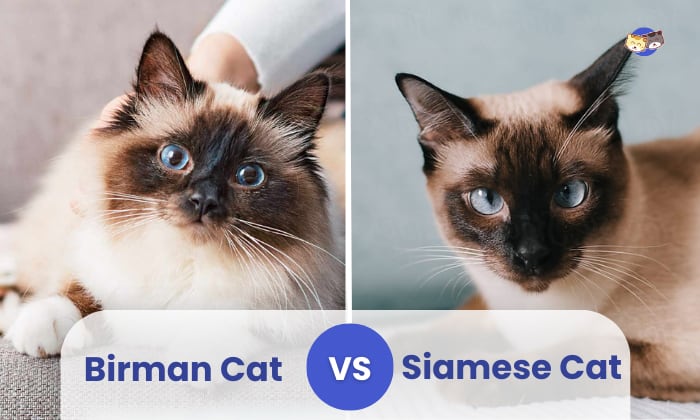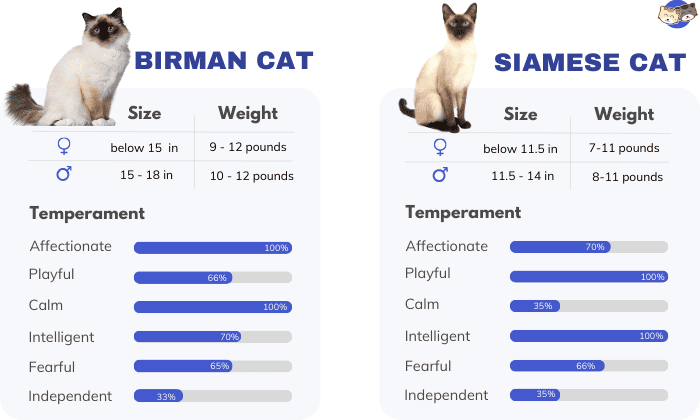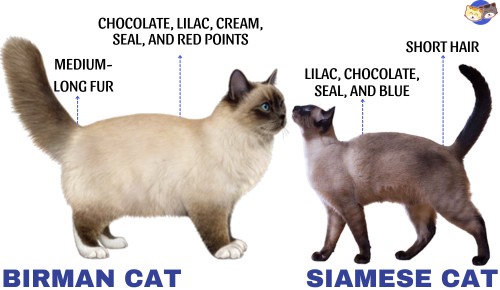The similarities of Birman and Siamese cats are uncanny, but those resemblances end in their physical aspects. A more comprehensive look at these feline breeds will reveal how much they differ.
If you are thinking of adopting any of these breeds, then knowing their differences is crucial to providing them with proper care. For instance, Birman and Siamese cats may have different diets.
So, without further ado, let’s compare the differences between Birman vs. Siamese cats.
| Birman | Siamese | |
| Size & Appearance | 15 to 18 inches long
Has a round head Features rounded ears and fluffy tail |
11.5 to 14 inches long
Features a triangular head Pointy ears and thin tail that tapers to the end |
| Hair Type & Color | Medium to long hair
Colorpoint pattern: chocolate, lilac, cream, seal, and red points |
Short, sleek fur
Colorpoint pattern: lilac, chocolate, seal, and blue. |
| Temperament | Friendly and easygoing
Does well around people, even strangers Can do well even when alone |
Less active than Siamese
Shy around strangers Don’t do well when left alone |
| Price | Ranges from $400 to $2,000 | Costs around $600 to $1,200 |
Table of Contents
Overview of the Birman Breed
The Birman cat, also known as the “Sacred Cat of Burma,” is popular for its striking appearance and striking personality. These felines are characterized by the color points on their ears, faces, tails, and paws.
The species is believed to have originated from Burma (what Myanmar went by before 1989). How this breed came about remains a mystery even to this day, although it’s well-known that Birman cats almost went extinct during World War II before they were brought to Britain in the 1960s for breeding programs.
Birman felines were officially recognized as a legitimate cat breed in the US in 1967.
Overview of Siamese Cats
The Siamese cat is one of the most recognizable and iconic breeds of domestic cats, known for its striking color points, blue almond-shaped eyes, and vocal personality.
According to popular beliefs, these cats came from ancient Thailand, then called Siam. No one knows when Siamese cats were introduced to Europe and America. However, it is believed that one of the first pairs was important in 1884 as a gift to Lilian Jane Gould, the sister of the British Consul-General in Bangkok.
Gould then formed the Siamese Cat Club in the 20th century, allowing the breed to proliferate.
Differences
1. Size & appearance
Birman cats are medium-sized felines, averaging around 15 to 18 inches long, that usually weigh 10 to 12 pounds. Meanwhile, Siamese cats are shorter and lighter, most measuring 11.5 to 14 inches long and weighing 7 to 11 pounds.
Siamese felines have thin tails and triangular heads with short and pointy ears. In contrast, Birman cats are known for their broad skulls. medium-sized rounded ears, and fluffy tails.
2. Hair type and color
Siamese felines are popular for their short hair, while Birman cats have medium to long fur.
As for the hair color, there isn’t much difference because Birmans are cat breeds similar to Siamese but aren’t related to them. Both breeds are color-pointed, which means their ears, noses, tails, and legs are darker than the rest of their bodies.
The difference in the color points of these cats is that Birmans usually have chocolate, lilac, cream, seal, and red points. Meanwhile, the Siamese have lilac, chocolate, seal, and blue.
3. Temperament
Siamese cats are friendly. They love being around people, even those who they are not familiar with.
In addition, this species is more active and noisy than Birmans. They are also easygoing, although they do well with being alone for hours.
Meanwhile, Birman cats are playful and inquisitive but less active and vocal than the Siamese.
This breed also doesn’t do well alone, so you either have to be home all the time or adopt another cat they can bond with.
4. Cat price
Birman cats are considered rare, so they are more expensive than Siamese cats.
They cost anywhere around $400 to $2,000 from a reputable breeder. On the other hand, Siamese felines usually cost $600 to $1,200.
When buying any of these cats, make sure you’re buying from a trusted breeder, as some less reputable ones may sell Birman-Siamese mix kittens for the price of a pure-bred one.
Which Cat is Right for You?
Choosing the right cat breed involves considering various factors such as your lifestyle and environment. This way, you can ensure that the cat’s breed, personality, and needs will suit your lifestyle.
These are the factors you need to consider when choosing between Birman and Siamese cats:
1. Personality
Can you tolerate noise, or do you want to keep your home quiet? If your answer is the latter, a Birman cat is a better choice, as they are quieter than the Siamese.
But if you want a cuddly feline, a Siamese cat is a good choice due to its active personality.
2. Environment
Since Siamese cats are active cats, they do well in homes with a lot of people. They enjoy the company of humans and other animals.
Meanwhile, Birman cats are ideal for homes that rarely have visitors. These cats don’t do well with strangers and tend to stick around their caretakers alone.
Conclusion
When choosing between Birman vs. Siamese cats, you need to consider not only your living conditions but also the breed’s personality and needs. This way, you can ensure that you are getting the right breed while your chosen breed is getting a quality life.
The cat’s activity level should match your own so that it gets that amount of affection and playtime it needs.
Whatever your choice is, it’s good to start by researching the two breeds’ personalities and needs. This way, you’ll have enough information about your chosen feline once you bring it home.
Related:

I am Amy Sawy, a Doctor of Veterinary Medicine (DVM) graduate from the University of Kansas. y husband, Dr. Plummer, and I own a veterinary clinic in Phillipsburg, Kansas. In addition to my professional background, I am a devoted pet owner myself, with a household that includes dogs, rodents, and most notably, cats – a total of five felines in my home.
In 2020, I joined an organization as a professional writer, leveraging my experience and collaborating with my team to deliver the most valuable information for your cat’s care.

















